This month September 2022 marks the sixth anniversary of my mother’s death. I wrote a lot of blog posts about her during the final years of her life. She loomed large over my entire life, but in her last decade, even more, as she and the whole family struggled with her Alzheimer’s Disease.
I wrote this post in 2014, while I was pursuing an art degree at the University of Southern Maine. Because I’m thinking about and missing my mother a lot right now, I thought it fitting to retell the story.
A drawing assignment
In 2014, we got an assignment in one of my drawing classes that I realized had my mother’s lost memories written all over it. And because I love writing as much as I love making art, I was compelled to write a blog post about the piece I decided to create.
This was the assignment:
Using cardboard as a base, create a freestanding or wall-hung work that involves multiple parts and the idea of the door or passage as metaphor. Along with this, it should embody references, either through representation or non-objective means, to notions of change. These may be relative to place, personal identity, or social history. There should be a use of symbolism and metaphor. Draw from personal memories and experiences and educational experiences. It must be made so that it can be relatively easily installed and transported.
I read over the assignment multiple times — the first time, I was like, WHAT DOES HE WANT US TO DO?? The second time, too! Once I grasped the concept, I couldn’t shake the thought of my mother and the hidden, missing pieces of her memory.
Two metaphors immediately came to mind — a hidden door and jigsaw puzzles. I also pictured a bookcase. She always loved books, although in between raising eight kids and living the vagabond life of an Army wife, she rarely had time to read any.
Because of Alzheimer’s she might enjoy the act of reading a book, but each time she opened one, it would be like the first time. She also couldn’t keep track of one sentence to the next.
My mother’s bookcase
I decided that my work would center around a cardboard bookcase. My mother’s bookcase. On the top shelf, I placed pictures of what she considered significant events and achievements — her marriage to my father and a family portrait that was taken a few years before he died.
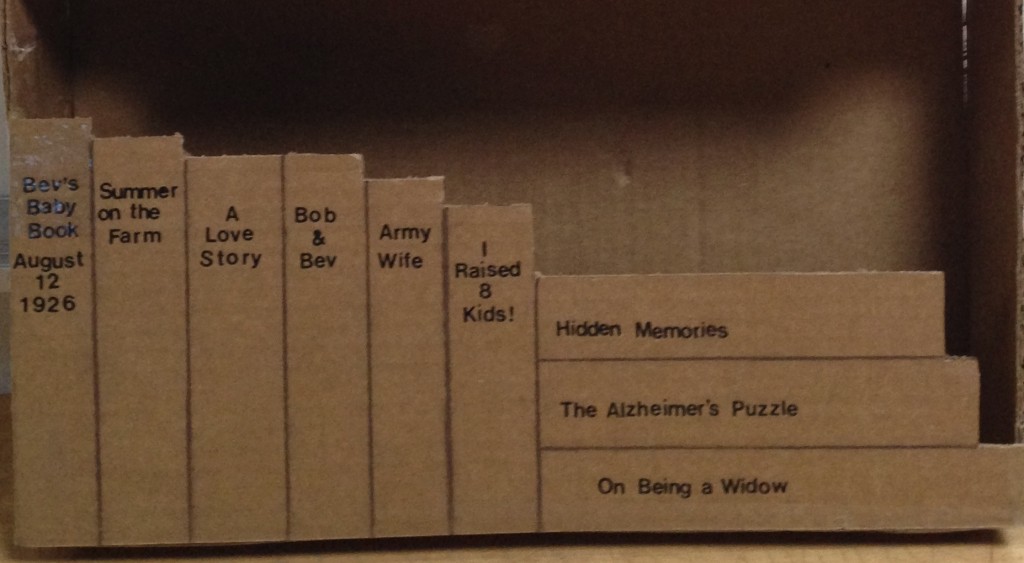
On the bottom shelf, I created a row of book spines, some with titles that represented what I thought were meaningful memories and others with titles that represented her reality at the time. Not a complete picture of her past or her present, by any means. Merely a glimpse.
On the middle shelf, I glued down a photo album and a jigsaw puzzle. Sometimes, when I would see her struggle to grasp what was going on, I imagined that the inside of her brain was like a puzzle that she couldn’t quite put together. It was also filled with a jumble of images of her past. Babies being born, her mother, a beloved grandfather, the different places she had lived, and friends she had made along the way.
If you tugged on the album and the box, a hidden door was revealed.
Right to the end, if you met my mother you might not immediately realize that she had Alzheimer’s. She would greet everyone with a smile and usually found something to admire — their own smile, their eyes, what they were wearing.
In the moment, she was quite present. Before long, though, the signs came out of hiding. Ask about her day and she’d tell you she didn’t know what was going on from one moment to the next. If she and I had just returned from a long ride in the country that she enjoyed immensely, she wouldn’t be able to recall a single thing. She might ask you a question and moments later repeat it almost word for word.
So many memories locked away. Hidden. Behind the door.
We had to include at least one drawn element in our project, so I decided to draw my mother from a picture I took of her while she was working on a jigsaw puzzle. The year before, I wrote about her doing a children’s puzzle. She was always a whiz at puzzles, but by then, not so much. She’d pick up a piece and turn it over and over trying to figure out where it belonged.
I’m so grateful that she always remembered the names of us children and could rattle the off in order. Diane, Debi, Cathy, Bob, Bruce, Mary, Patrick, and Becky. She mixed up our children’s names though and who they belonged to sometimes, and could never hang on to her great grandchildren’s names.
Under her portrait, I created a family jigsaw puzzle. As you can see, a few of the pieces were missing. I used to hold my breath waiting for her to lose the piece that was me. We all did, but she never forgot her children’s names, not even on the day she died.
Beverley Swett 1926-2016. Always in our memories.

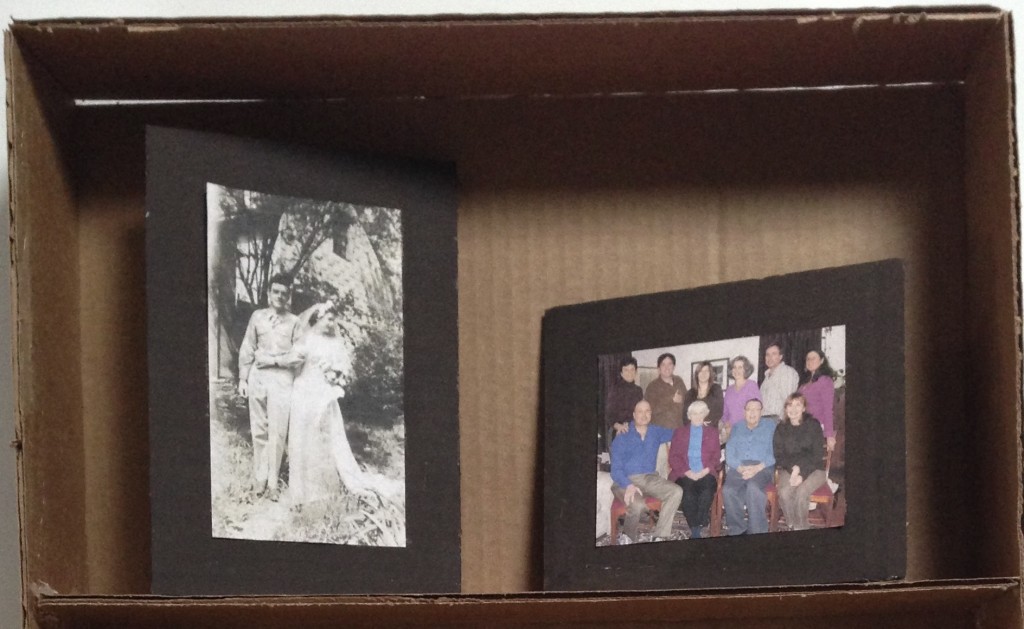
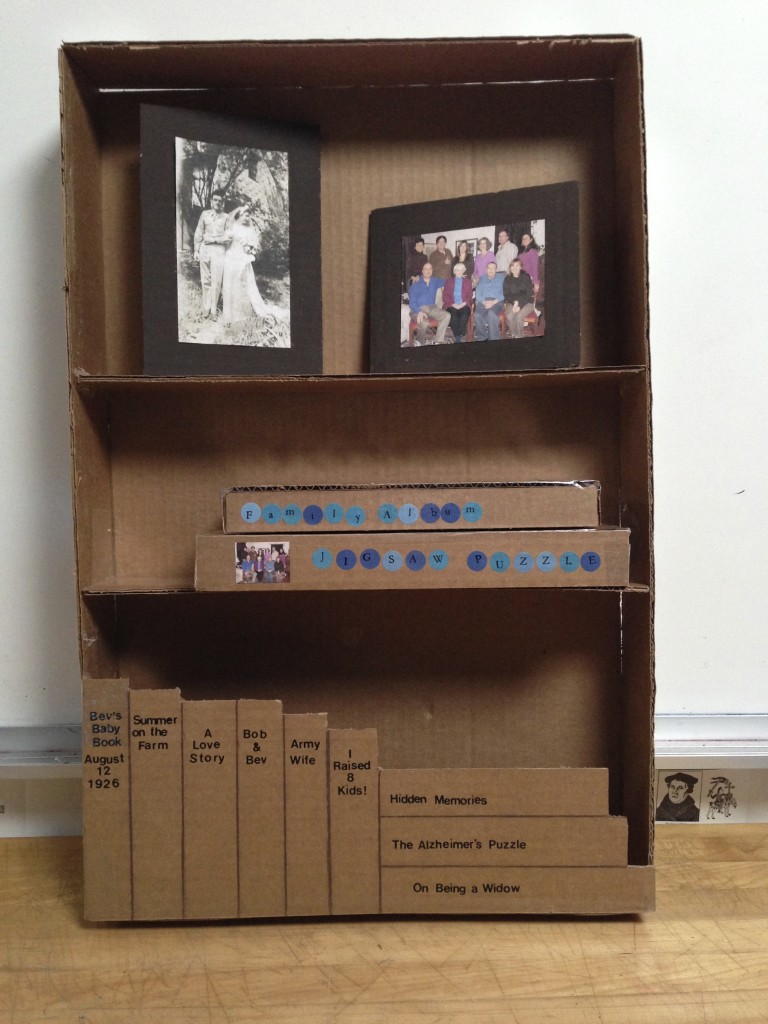
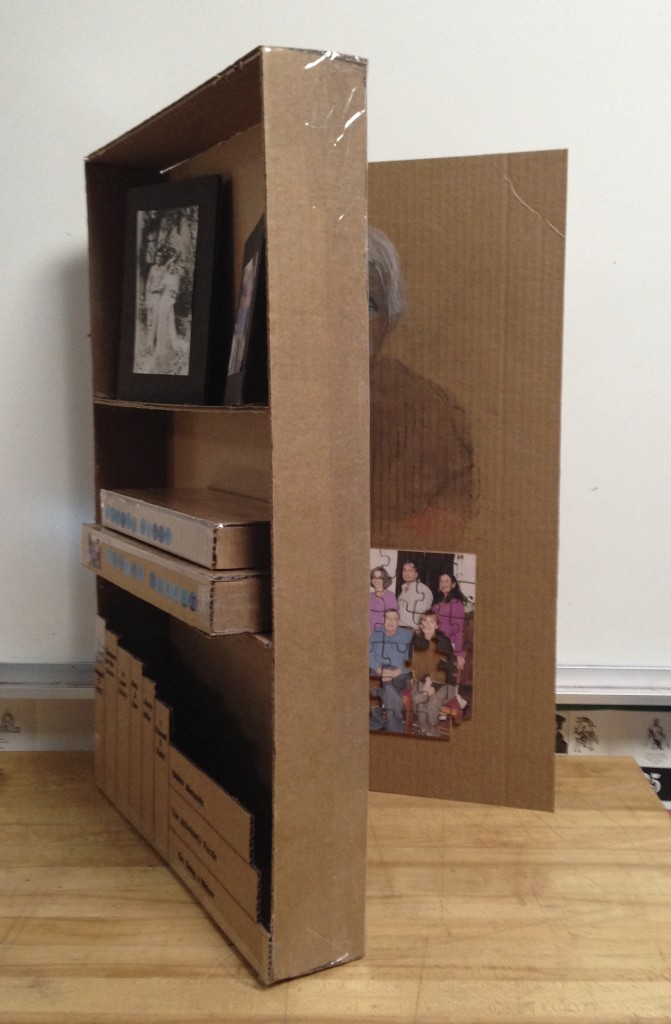
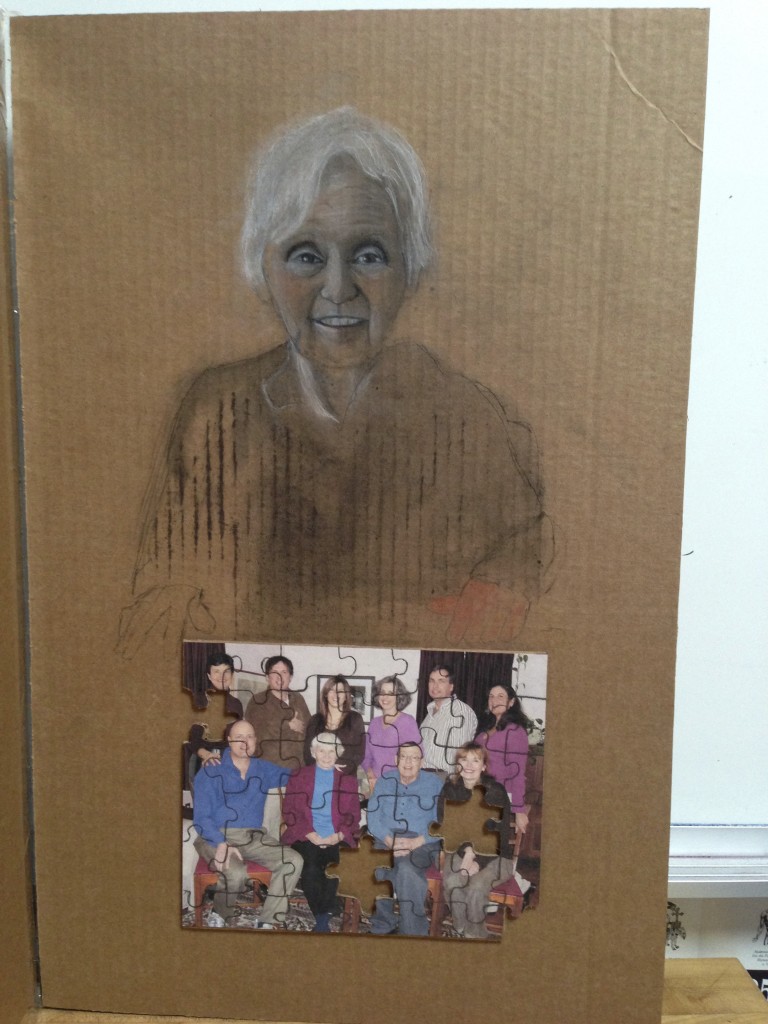
Diane,
Thank you for sharing your mom’s story, you’re right Alzheimer’s is like a puzzle. I’ve seen and known many people including relatives with it and your art piece tells the story.
Hopefully someday there will be a cure and families won’t have to see their loved ones going through this disease anymore.
It’s a terrible disease Jeanie. There’s a lot of research going on now so
we have reason to be hopeful.
A beautiful project Diane filled with wonderful memories. She was full of life indeed.
A very warm and welcoming smile.
Love you, Bruce
Diane,
Thank you so much for sharing this.
I enjoyed the time that I spent with your Mom (“BeverlEy”) while working as a caregiver with VNA. We shared a lot of laughs, a lot of visits to Goodwill, and her love for KitKats!
One of the most poignant things she shared with me was when she said that she often felt like she was looking through a kaleidoscope trying to make sense of things. That has always stayed with me.
Fondly,
Pam
I did some checking on that name spelling. Birth certificate is with an e and passports no e. Also, I wrote another blog post about the kaleidoscope. I’ll look for it and reply again with the link.
Found the kaleidoscope post! https://dianeatwood.com/a-kaleidoscope-in-her-head/
I love this, Diane! I am also missing my mother terribly. She has been gone for three months now. Thanks for inspiring me to create something like this to remember her!
I want to see what you create, Nancy!
Thank you for sharing Diane. Your work of art and thoughtful gifts are amazing, you can still tell a story without all the words. I enjoy your blog on so many social issues and events in all our lives. You have touched many over the years. Keep up the great things you are doing and helping us find that innermost emotional connections to all in our life’s journey. Thank you and many blessings to you.